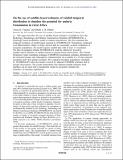On the use of satellite-based estimates of rainfall temporal distribution to simulate the potential for malaria transmission in rural Africa
Author(s)
Yamana, Teresa K.; Eltahir, Elfatih A. B.
DownloadEltahir_On the use of satellite.pdf (1.378Mb)
PUBLISHER_POLICY
Publisher Policy
Article is made available in accordance with the publisher's policy and may be subject to US copyright law. Please refer to the publisher's site for terms of use.
Terms of use
Metadata
Show full item recordAbstract
[1] This paper describes the use of satellite-based estimates of rainfall to force the Hydrology, Entomology and Malaria Transmission Simulator (HYDREMATS), a hydrology-based mechanistic model of malaria transmission. We first examined the temporal resolution of rainfall input required by HYDREMATS. Simulations conducted over Banizoumbou village in Niger showed that for reasonably accurate simulation of mosquito populations, the model requires rainfall data with at least 1 h resolution. We then investigated whether HYDREMATS could be effectively forced by satellite-based estimates of rainfall instead of ground-based observations. The Climate Prediction Center morphing technique (CMORPH) precipitation estimates distributed by the National Oceanic and Atmospheric Administration are available at a 30 min temporal resolution and 8 km spatial resolution. We compared mosquito populations simulated by HYDREMATS when the model is forced by adjusted CMORPH estimates and by ground observations. The results demonstrate that adjusted rainfall estimates from satellites can be used with a mechanistic model to accurately simulate the dynamics of mosquito populations.
Date issued
2011-02Department
Massachusetts Institute of Technology. Department of Civil and Environmental Engineering; Parsons Laboratory for Environmental Science and Engineering (Massachusetts Institute of Technology)Journal
Water Resources Research
Publisher
American Geophysical Union (AGU)
Citation
Yamana, Teresa K., and Elfatih A. B. Eltahir. “On the Use of Satellite-based Estimates of Rainfall Temporal Distribution to Simulate the Potential for Malaria Transmission in Rural Africa.” Water Resources Research 47.2 (2011). Copyright 2011 by the American Geophysical Union.
Version: Final published version
ISSN
0043-1397